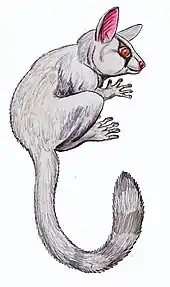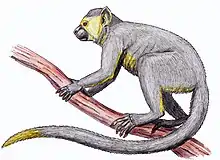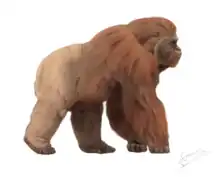| Bunopithecus Temporal range: Middle Pleistocene | |
|---|---|
| Scientific classification | |
| Domain: | Eukaryota |
| Kingdom: | Animalia |
| Phylum: | Chordata |
| Class: | Mammalia |
| Order: | Primates |
| Suborder: | Haplorhini |
| Infraorder: | Simiiformes |
| Family: | Hylobatidae |
| Genus: | †Bunopithecus Matthew & Granger, 1923 |
| Species: | †B. sericus |
| Binomial name | |
| †Bunopithecus sericus | |
Bunopithecus is an extinct genus of primate represented by one species, Bunopithecus sericus, a gibbon or gibbon-like ape. Its remains were first discovered in Sichuan, China, in strata from the Middle Pleistocene.[1]
Although the three hoolock gibbon species were once included in the genus Bunopithecus, they have recently been removed and B. sericus remains as the only known species of this genus.[1]
References
- 1 2 Mootnick, A.; Groves, C. P. (2005). "A new generic name for the hoolock gibbon (Hylobatidae)" (PDF). International Journal of Primatology. 26 (4): 971–976. doi:10.1007/s10764-005-5332-4. S2CID 8394136. Archived from the original (PDF) on 2011-09-27.
This article is issued from Wikipedia. The text is licensed under Creative Commons - Attribution - Sharealike. Additional terms may apply for the media files.



